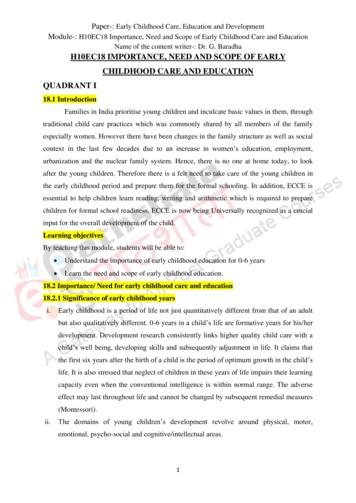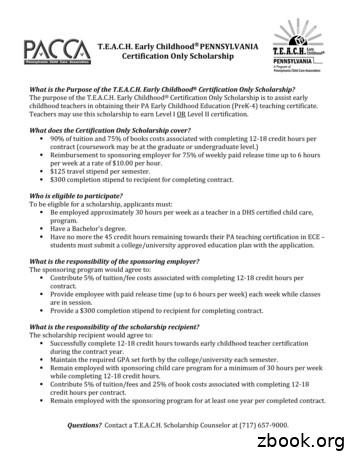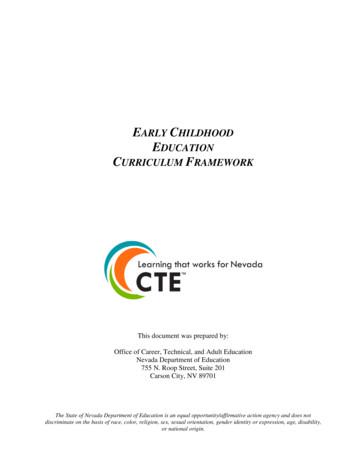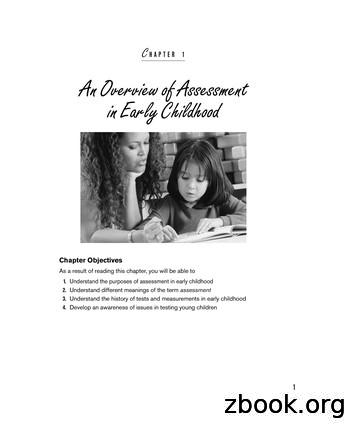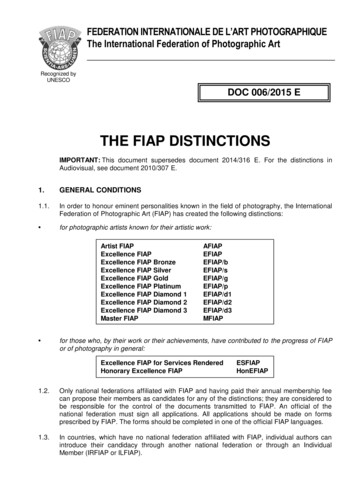Ohio’s Early Childhood
Ohio’s Early ChildhoodCore Knowledge & Competencies
Table of ContentsINTRODUCTION1PART 1: OVERVIEWFramework44Content Areas Defined4Table of ContentsOverarching ConsiderationsDispositions5Connections65Uses of the Early ChildhoodCore Knowledge & Competencies7Highlights of the Revised Early ChildhoodCore Knowledge & Competencies 88AcknowledgmentsPART 2: CONTENT AREAS9A. Child Growth & Development12B. Family & Community RelationsC. Health, Safety & NutritionD. Observation & AssessmentE. Professionalism18263442F. Learning Environments & ExperiencesPART 3: RESOURCESAppendix 1: Glossary485354Appendix 2: Research References57Appendix 3: For More Information59Appendix 4: Linkages with Primary Sources62
IntroductionYoung Children Are Amazing!PURPOSEInside the vulnerable, wobbly head of theyoungest newborn is a stunning amountof sophisticated brain activity! Thanks tomodern science, we are just beginning tounderstand how equipped and capablechildren are from the start to learn, tofunction, to adapt, and to make sense ofthe world in which they are born.The Ohio’s Early Childhood Core Knowledge& Competencies (EC-CKC) is based on theunderstanding that there are critical areasof knowledge and skills that are necessaryfor early childhood professionals to have ifyoung children are to learn and grow undertheir care. The EC-CKC strives to clearlycommunicate the nature of these criticalareas of professional practice and be useful toanyone who is interested in the competencyof early childhood professionals, whetherit be those working or considering work inthe field, those families who depend uponearly childhood services, or those who makedecisions and policies about early childhoodprofessionals.IntroductionAbility Alone Is Not EnoughBut modern science has also shown thatthe amazing capabilities of each child arenot enough by themselves to ensure healthand well-being, readiness for school, and asuccessful passage into a productive, happyadulthood. Decades of research have made itclear – the adults who care for and educateyoung children will shape: children’s understanding of themselves,others and the world around them the pathways of children’s physical,social, cognitive, and emotionaldevelopment the very structure of the young child’s brainParents, of course, are their children’s firstand most important caregivers and teachers.During the course of their early years,however, most of the children in Ohio willalso have their development and experiencesshaped by at least one early childhoodprofessional – someone whose professionallife is dedicated to the well-being of youngchildren, and their families. In this document,you will discover the knowledge and skillsthat are needed to fully foster youngchildren’s inborn capabilities.INTRODUCTIONA NOTE ABOUT WORDINGIn writing this document, key decisions weremade about language that would be used.The EC-CKC was developed by people in awide variety of experiences and roles withinthe early childhood profession and definesand describes what we, as early childhoodprofessionals, know and do and why. It isintended to be a statement from us, theearly childhood professional communityin Ohio, and it is our sincere desire thateach of you who share in this work willsee yourself in these pages and feel thatyou are well represented here.Early childhood professional is the termchosen for those whose work is representedin the EC-CKC. It is intended to include notonly those who have the responsibility forthe direct care and education of youngchildren but all those whose primary workresponsibilities are related to the well-beingof children birth to kindergarten entry. Theseprofessionals, though they are found in awide variety of roles and settings, share acommon goal of ensuring young children’shealthy development, and joy in learning.Learning and development settings is theterm used to represent the various typesof programs that provide early care andeducation to Ohio’s children from birth tokindergarten entry. The EC-CKC was writtento represent the professional knowledge andskill needed in all of these settings.Professional practice is the term chosen todescribe the early childhood professional’swork. It is a phrase intended to include allof the activities and responsibilities – the“practices” – of work focused on youngchildren and their families.Recommended practices is the termchosen to describe professional practicesthat are generally considered to bethe most highly recommended by thefield, based on current research and theknowledge of expert practitioners at thistime. It is understood that, as new evidencearises, the practices that are recommendedin the care and education of young childrenmay change.A glossary can be found in Part C:Resources that defines many more of theterms used throughout the EC-CKC andwithin specific content areas. Words thatare defined in the glossary are italicized.1
WHAT AND WHYCore knowledge and competencies definewhat all adults who work with young childrenneed to know, understand and be able todo in order to ensure that children have thebest possible environments, experiences andrelationships in which to grow and learn.The EC-CKC is based on all that we currentlyknow about young children’s development,learning, and school readiness from researchas well as the combined wisdom of leaders inour field.IntroductionHaving clearly defined core knowledgeand competencies has many benefits:INTRODUCTION Work with young children gains importanceas a profession when everyone understandsthat it requires specialized knowledge, skillsand dispositions gained through educationand ongoing professional development. The EC-CKC represents the scope ofprofessional practice and providesa comprehensive framework for thepreparation of newcomers to the field andthe continued professional growth of thosealready working with young children andtheir families. Lastly, a document that covers a rangeof competencies from entry levelto mastery level is a helpful tool asindividuals assess their own knowledgeand skill level and chart a course forprofessional development.GUIDING PRINCIPLESThe process of creating and revising theEC-CKC for Ohio’s early childhoodcommunity involved the wisdom, creativity,and passion of a committed group ofthe state’s early childhood professionalsrepresenting diverse roles and settings.The writing teams who developed andrevised the EC-CKC were strongly committedto a set of eight guiding principles. Theirgoal was to create a document that:3. Represents knowledge and observableskills needed for all levels of professionals,from beginners just entering the fieldthrough those at an expert level4. Applies to the development, careand learning of children from birth tokindergarten entry5. Recognizes that children with specialneeds are included in the populationthat all early childhood professionals serve6. Is culturally sensitive and respectful7. Is based on what is currently known,from research and expert wisdom, aboutyoung children and the practices that bestsupport them in their development andlearning8. Is reader-friendly and useful in avariety of ways1. Identifies the key concepts that applyto anyone working with young childrenin a learning and development setting2. Applies to early childhood professionalswho provide care and/or education in manydifferent settings and roles2
Part 1Overview
OverviewFRAMEWORKCONTENT AREAS DEFINEDSix broad content areas were identified askey categories of specialized knowledge andskill that shape early childhood professionalpractice. Here we give general definitionsof each. They are in no particular order andshould be seen as equally important areasthat are connected.OverviewChild Growth & Development:Early childhood professionals base theirpractice on an understanding of all ofthe ways that children change over time,including expected patterns of developmentas well as the many ways that individualchildren can differ. They also understandand take into consideration the impactof relationships and the environment onchildren’s well-being and growth.Family & Community Relations: Earlychildhood professionals understand howimportant it is that they know the family,culture and community setting in whicheach child lives. They also appreciate thatstrong, positive connections to families andcommunity resources benefit children.Health, Safety & Nutrition: Early childhoodprofessionals realize the importance ofchildren’s physical well-being as a basicand necessary foundation for their growth,development and learning, and theyunderstand the many ways of nurturing it.Child Observation & Assessment:Early childhood professionals are ableto continually improve each child’s careand learning experiences because theyPART 1Overviewunderstand that every child follows aunique path. So they gather and applyinformation about each child’s progress aspart of their regular practice.become competent in each area of practice.This knowledge provides the cognitivefoundation for the skills and behaviorsdefined in the competencies section.Professionalism: Early childhoodprofessionals see themselves as members ofa larger professional community and acceptthe responsibilities that go along with beinga positive reflection on the profession and apositive contributor to the profession.Competencies: This section identifiesspecific observable behaviors and skillsdisplayed across three levels of understandingand offers professionals an opportunity toreflect on their level of knowledge withina content area.Learning Environments & Experiences:Early childhood professionals understandthat children are born with the capacityand motivation to learn, and that children’slearning is enhanced when professionalsintentionally use a curriculum informed bystandards of children’s typical developmentand learning from birth to age five,knowledge of individual children, andknowledge of effective and appropriatestrategies to scaffold learning.In Appendix 3, a list of additional resourcesis provided for each content area if moreinformation on that topic is desired.SectionsEach of the six content areas hasthree sections:Rationale: This section states the reasonsthat the content area is essential in theearly childhood professional’s day-to-daypractice. The statements identify the effectof professional competency on children andfamilies and are based on current researchand standards of practice. A list of theresearch references used in creating eacharea’s rationale is provided in Appendix 2.Knowledge Base: This section defines theconcepts a professional must learn in order toCompetency LevelsIn order to represent the developmentof professional practice over time,competencies are given for three levels.All early childhood professionals would beexpected to possess Level 1 competencies.As they continue learning and advancingtheir knowledge and skills, they would beexpected to add the competencies inLevel 2 and, eventually, Level 3.Level 1: Entry Level Professionals havean understanding of the basic programand regulatory processes related to theprofession. These professionals also have abasic understanding of content within eachcore competency and relate this knowledgeto their professional responsibilities. Althoughthey may have the basic concepts relatedto each core competency, Entry LevelProfessionals still require frequent supportfrom more experienced professionals aswell as additional professional development4
and/or education. Entry Level Professionalsmay be new to the field or have little formaltraining in their profession.Level 2: Experienced Level Professionalsdemonstrate the knowledge andcompetencies in the Entry Level and relatethe content to their profession. Theseprofessionals apply their knowledge of corecompetencies to the responsibilities withintheir profession to ensure that they aremeeting the individual needs of children andfamilies. Experienced Level Professionals mayseek support from others when they identifya need. Experienced Level Professionals haveat least three years of experience and/orformal training in their profession.OverviewLevel 3: Advanced Level Professionalsdemonstrate the knowledge andcompetencies in Entry and Experienced levelsand evaluate and assess their practice in theirprofession. These professionals have deepknowledge across the core competenciesand utilize this knowledge to evaluate andmake changes to ensure the use of bestpractices in their profession. Advanced LevelProfessionals serve as mentors and leaders intheir profession. Advanced Level Professionalshave at least five years of experience andformal training in their profession.The intent is not to label professionalsas Level 1, 2 or 3. Rather, the intent is toprovide a tool for professional growth.Just as young children typically showdifferent levels of skills across the areas oftheir development, each early childhoodprofessional will have a developmental“profile” that reflects areas of varying levelsof competence across the different contentareas. As with children, identifying specificPART 1Overviewareas of lesser competence is the first stepin creating goals for progress and identifyingways of achieving those goals. As the earlychildhood professional gains knowledgeand skill through self reflection, professionaldevelopment education, etc., she/he canexpect to see changes in that profile.OVERARCHING CONSIDERATIONSSome aspects of professional practice spanall six content areas. In identifying the coreknowledge and competencies within each,consideration was given to: the inclusion of children with special needs the differences among children and familiesdue to such influences as culture, familystructure, or religion behavior as a means of communication foryoung children and the responsibility of theprofessional for understanding and guidingyoung children’s behaviorDISPOSITIONSEvery profession has a set of attitudes, beliefsand views that distinguish its members as agroup. Together they are called professional“dispositions.” The early childhood professionalso has dispositions that are highly valuedamong its members. Although dispositionsare an important element of professionalpractice, they are different than professionalknowledge and competencies. Dispositionsdescribe how a person approaches all aspectsof the work of the early childhood professionrather than what is known and done. Becausedispositions apply to all members of the earlychildhood profession and are evident in everyaspect of their work, we’ve chosen to listthem separately.The exemplary early childhood professionalis one who:1.delights in and is curious about childrenand how they grow and learn2. appreciates and supports the unique andvital role of parents and families in theirchildren’s lives3. is eager to learn new knowledge andskills that will support young children’sdevelopment and learning4. models the attitudes and behaviors thatshe/he values in children5. values and celebrates the diversity foundamong children and their families and inthe world around them6. is willing to ask for help, to learnfrom others, and to acceptconstructive criticism7. reflects on the personal beliefs andvalues that influence her/his ownattitudes and practices8. accepts responsibility for her/hisown actions9. shows respect for children, families, andcolleagues by maintaining confidentiality10. responds to challenges and changes withflexibility, perseverance and cooperation11. expresses her/his own emotions in healthyand constructive ways12. values and nurtures imagination,creativity and play, both in childrenand in herself/himself13. has a collaborative attitude5
CONNECTIONSOhio DocumentsThe EC-CKC is an important addition to agrowing collection of key Ohio documentsrelated to early childhood. The EC-CKCsupports, aligns with, and complementsthese documents. The following sectionclarifies the similarities and differencesbetween these key documents.Ohio’s Early Childhood Core Knowledge& CompetenciesFocus: early childhood(birth – kindergarten entry) professionalsContent: professional knowledge and skillsFormat: six areas of professional practice,three levels of competencyOverviewOhio’s Early Learning andDevelopment StandardsFocus: young children(birth–kindergarten entry)Content: development and learningexpectations for childrenFormat: five developmental domains madeup of strands, which are further divided intotopics, each topic has standard statementsOhio’s Standards for the Teaching ProfessionFocus: licensed classroom educators,preK-grade 12Content: professional knowledge and skillsFormat: seven standards or aspectsof professional practice, three levelsof performancePART 1OverviewOhio’s Core Knowledge & Competenciesfor Program AdministratorsFocus: administrators of programs that servechildren, birth-grade 6Content: professional knowledge and skillsspecific to program administrationFormat: five areas of professional practice,three levels of competencyNational DocumentsThe EC-CKC also aligns with key documentsof national organizations in the earlychildhood profession. In writing the EC-CKC,we believed it was important to show clearlinks to three important source documentsfrom two leading organizations in the field,the National Association for the Educationof Young Children (NAEYC) and the Councilfor Exceptional Children/Division of EarlyChildhood. The following documents areclosely related to the EC-CKC and wereused as resources in its development: DEC Recommended Practices in EarlyIntervention/Early Childhood SpecialEducation identifies recommendedpractices in seven different aspects ofserving children with special needsA table is provided in Appendix 4 thatshows which EC-CKC areas link with whichstandards/recommended practices fromthese three source documents.Career PathwaysFinally, the EC-CKC and Ohio’s CareerPathways framework each reflecta progression and accumulation ofprofessional knowledge and skill. Althoughthis progression is represented as “levels”in both frameworks, the levels representa similar concept rather than a directcorrespondence between the two. NAEYC Standards for Early ChildhoodProfessional Preparation Programsidentifies standards for higher educationprograms that prepare early childhoodprofessionals and states the knowledgeand skills that students should have afterreaching different levels of educationalachievement. NAEYC Early Childhood ProgramStandards and Accreditation Criteriaarticulates standards of excellence forten different aspects of learning anddevelopment programs6
USES OF THE EC-CKCOverviewAUDIENCEPART 1OverviewUSEEarly Childhood Professionals Self-assessment; identify knowledge or competencies to acquire Create a plan for developing as a professionalProgram Administrators ProfessionalDevelopment Providers Organize and identify in-service professional development using EC-CKC areas and levels Assess current availability of professional development opportunities across all content areasand all levels of competency Use as framework for developing comprehensive system of professional developmentHigher Education Assess current program content to guide course development Use as a resource as colleges seek accreditation or alignment with NAEYC Standards forEarly Childhood Professional Preparation Match level of competency with the level of coursework within the degree of the program Use as a model for student assessment Expose pre-service candidates to future employment requirements Use framework to facilitate articulation between institutionsState and Local Agencies Develop policy, initiatives and funding decisions that will increase the level of competencyof early childhood professionals Identify common goals to improve inter-agency coordinationEarly Childhood Advocates Educate parents, policymakers and general public about the areas of professional practice inearly childhood and the need for competent professionals Reinforce the concept and language of professionalism for the field of early
the early childhood profession and deines and describes what we, as early childhood professionals, know and do and why. It is intended to be a statement from us, the early childhood professional community in Ohio, and it is our sincere desire that each of you who share in
Understand the importance of early childhood education for 0-6 years Learn the need and scope of early childhood education. 18.2 Importance/ Need for early childhood care and education 18.2.1 Significance of early childhood years i. Early childhood is a period of life not just quantitatively different from that of an adult
T.E.A.C.H. Early Childhoodâ PENNSYLVANIA Certification Only Scholarship What is the Purpose of the T.E.A.C.H. Early Childhood Certification Only Scholarship? The purpose of the T.E.A.C.H. Early Childhood Certification Only Scholarship is to assist early childhood teachers in obtaining their PA Early Childhood Education (PreK-4) teaching certificate.
Early Childhood Education I L1 Early Childhood Education II L2 Early Childhood Education III L3C Early Childhood Education Advanced Studies AS The core course sequencing with the complementary courses provided in the following table serves as a guide to schools for their programs of study.
CHAPTER 1 An Overview of Assessment in Early Childhood Understanding Assessment in Infancy and Early Childhood Not too long ago, resources on early childhood assessment were limited to occa-sional articles in journals, chapters in textbooks on teaching in early childhood pro-grams, and a few small textbooks that were used as secondary texts in .
ECE 240 - Administration of Early Childhood Care and Education Programs (3) ECE 241 - Administration: Human Relations for Early Childhood Education (3) Colorado Mesa University B.A. Early Childhood Education - Early Childhood Special Education Advisor: Vail Shoultz-McCole vshoultz@coloradomesa.edu 970-255-2674
Early Childhood Care, Development and Education (ECCDE) is a term that is used interchangeably worldwide but refers to the same concept of early childhood education and cognitive development. The World Bank for instance refers to it as Early Childhood Care and Education, whereas UNESCO refers to it as Early Childhood Development Care.
2016 Ohio IT 4708 General Instructions New Ohio IT K-1 Use the Ohio IT K-1 to report each investor's or beneficiary's proportionate or distributive share of the partnership's, corporation's, estate's or trust's Ohio income and credits. Each entity with Ohio income should prepare a separate Ohio IT K-1 for each investor or
For the EFIAP/d2 100 awards with 30 different works in 7 different countries For the EFIAP/d3 200 awards with 50 different works in 10 different countries 4.3. The candidate for an "EFIAP Level" distinction must submit: a) A complete application using forms prescribed by FIAP (which can be downloaded from FIAP’s website, see 9.1.). b) A number of photographs as indicated hereunder: These .

